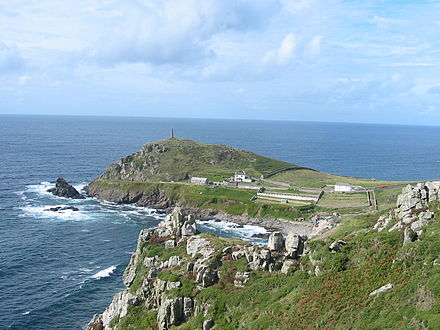Cape Cornwall
Cape Cornwall
| |
|---|---|
 Headland of Cape Cornwall | |
Location within Cornwall | |
| OS grid reference | SW371315 |
| Unitary authority | |
| Ceremonial county | |
| Region | |
| Country | England |
| Sovereign state | United Kingdom |
| Post town | PENZANCE |
| Postcode district | TR19 7 |
| Dialling code | 01736 |
| Police | Devon and Cornwall |
| Fire | Cornwall |
| Ambulance | South Western |
| UK Parliament | |
Cape Cornwall (Cornish: Kilgoodh, meaning "goose back")[1] is a small headland in West Cornwall, England. It is 4 miles (6.4 km) north of Land's End near the town of St Just.[2] Until the first Ordnance Survey in the early 19th-century, Cape Cornwall was believed to be the most westerly point in Cornwall.[3]
Most of the headland is owned by the National Trust. National Coastwatch has a look-out on the seaward side. The only tourist infrastructure at present is a car park (owned by the National Trust), public toilets, and a refreshments counter during the summer.
The Brisons, two offshore rocks, are located approximately 1 mi (1.6 km) southwest of Cape Cornwall. They mark the starting line of the annual swimming race ending at Priest Cove.[2][3]
Etymology
The name Cape Cornwall appeared first on a maritime chart around the year 1600. The original Cornish name, Kilgoodh Ust, dates back to 1580. In English it translates to "goose-back at St Just", a reference to the shape of the cape.[4] Later versions of the name dropped the 'Ust'.[1] An alternative name, Pen Kernow, is a recent translation back to Cornish of the English.
A cape is the point of land where two bodies of water meet. Cape Cornwall is one of only two capes in the United Kingdom, the other being Cape Wrath in North West Scotland.[5]
Early history
_edit.jpg/440px-Cape_Cornwall_(Judithili)_edit.jpg)
Pottery found in cists on the Cape have been dated to the Late Bronze Age. The presence of another cliff castle nearby (Kenidjack) may indicate that the area was important in the Iron Age. On the landward side of the Cape is the remains of the medieval St Helen's Oratory, which replaced a 6th-century church. A font now installed in the porch of St Just church may be from this building.[3]
19th-century to present

Cape Cornwall Mine, a tin mine on the cape, was operated intermittently between 1838 and 1883. The mine's 1864 chimney near the peak of the cape was retained as an aid to navigation. In the early 20th-century, the former ore dressing floors were for a time converted for use as greenhouses and wineries.
In 1987, the mine site was purchased by the H. J. Heinz Company of the United States (and British plants) and donated to the nation.[6] The remains of Cape Cornwall Mine are designated as part of the Cornwall and West Devon Mining Landscape, a UNESCO World Heritage Site.[7]
References
- ^ a b "Cape Cornwall". Akademi Kernewek.
- ^ a b Ordnance Survey: Landranger map sheet 203 Land's End ISBN 978-0-319-23148-7
- ^ a b c Joseph, Peter. 2006. Cape Cornwall Mine. British Mining No. 79. Sheffield: Northern Mine Research Society; p. 111. ISBN 978-0-901450-60-9.
- ^ Weatherhill, C. (2007) Cornish Place Names and Language. Ammanford: Sigma Press.
- ^ "Cape Cornwall. Just up the coast from Lands End, one of only two Capes in the United Kingdom". Cornwall by Cornishlight. Retrieved 28 October 2020.
- ^ "Trust remembers Heinz gesture". Business Cornwall. 25 May 2017. Retrieved 16 April 2023.
- ^ "Cape Cornwall". National Trust. Retrieved 16 April 2023.
External links
- Cape Cornwall at DMOZ
